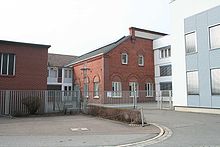LASCO Umformtechnik
| LASCO Umformtechnik GmbH
|
|
|---|---|
| legal form | GmbH |
| founding | 1863 |
| Seat | Coburg , Germany |
| management | Lothar Bauersachs, Thomas Götz, Robert Welsch |
| Number of employees | 474 (2012) |
| Branch | mechanical engineering |
| Website | www.lasco.de |
The LASCO GmbH produces machine tools and production lines for forming tasks ago. The company, founded in 1863, is still majority owned by the founding Langenstein family and is based in Coburg, Bavaria, in Upper Franconia .
Companies
The company develops and produces machine tools and production systems for metal forming, powder metallurgy and building material production. These include hydraulic presses for sheet metal forming and hydraulic forging hammers , but also hydraulic presses for the production of sand-lime bricks . The machine tool factory had a turnover of 47 million euros in 2012, for which it employed 342 people in Coburg. Lasco Umformtechnik is owned by Langenstein & Schemann GmbH, in which three family lines were involved until the end of 2008. Since July 1, 2009, two family lines and the former managing director Friedrich Herdan have been shareholders.
history
In 1863, the metallurgical specialist and foundry master Louis Langenstein from Laufach and the merchant Ludwig Schemann from Cologne acquired the Cortendorfer powder and fulling mill and founded the Cortendorfer iron foundry and machine factory , which was located on the western edge of Cortendorf on the Hahn river, a mill ditch of the Itz . The license to build the iron foundry was granted by the Ducal Saxon State Ministry in Coburg on April 21, 1863. From September 30, 1863, the factory was given permission by Duke Ernst II to call himself Ernst-Hütte . After the death of Louis Langenstein in 1884 and Ludwig Schemann in 1886, the son Carl Langenstein took over the management of the company and, after the death of Schemann's widow, also the shares of the Schemann family. In 1918 the company was renamed Langenstein & Schemann AG . The sons Alwin and Franz ran the company from 1928 to 1951 and 1961, respectively, followed by the fourth generation in 1961 with Hellmut, Rolf and Horst Langenstein. From 1986 to 2011, Friedrich Herdan was the first family member to run the machine tool manufacturer.
In addition to foundry products, the company initially manufactured water wheels , followed by the first water turbines in 1869 . Combustion engines and steam engines were also built at times . In the 1880s, the production of drop forging hammers began , which were mainly accepted by the weapons and tool factories in southern Thuringia. In the 1950s, deep drawing presses and special machines for non-cutting forming supplemented hammer construction. In the 1990s, machines for the production of sand-lime bricks were added to the product range. In 2012/13 a new production hall was built. The foundry building from 1958 was demolished.
Factory facilities
Some brick buildings on the factory premises are listed as architectural monuments in the Bavarian list of monuments . The oldest casting hall was built in 1888 by G. Stang from Mönchröden . The elongated hall structure still forms the core of the factory today; it represents the northwestern part of the building complex.
In 1903 G. Stang added a second casting hall in Winkel. The brick building with a gable roof immediately catches the eye at the factory gate. It has a straight gable wall and a colossal corner pilaster . The large windows on the ground floor have relief arches that are shaped as blind arcades. The situation is similar with the two windows on the upper floor on the gable side. Another machine hall, built in 1915, adjoins the northern long side of the building; the two halls are connected by a common gable wall.
In 1906 it became necessary to build a third foundry. Under the construction management of G. Stang, Knopf & Mücke from Leipzig then built the new hall in the southeast corner of the oldest casting hall. It has a wall structure typical for industrial buildings of that time with panel windows that are covered by protruding segmental arches.
At the far eastern tip of the property, W. Müller built the workers' house in 1916, along with a gate and canteen. The house has an unusual appearance; it has a trapezoidal floor plan and forms a “half” mansard hipped roof house with two storeys. The pure brick construction has five axes on the long side. Simple strip cornices form the storey separation; the only decorative accessory is a corner bay on the upper floor on a multi-tiered console.
See also
literature
- Peter Morsbach and Otto Titz: City of Coburg. Ensembles-Architectural Monuments-Archaeological Monuments . Monuments in Bavaria. Volume IV.48. Karl M. Lipp Verlag, Munich 2006, ISBN 3-87490-590-X , p. 437.
- Hans Tischert: Stations in a Hundred Years of History 1863–1963 . Langenstein & Schemann AG - Ernsthütte - machine factory and iron foundry Coburg (Bavaria).
Individual evidence
- ^ Coburger Tageblatt: New Year's Eve 2009
- ↑ Coburger Hochschulmagazin, Issue 17, July 2009 ( Memento of the original from August 12, 2014 in the Internet Archive ) Info: The archive link was inserted automatically and has not yet been checked. Please check the original and archive link according to the instructions and then remove this notice. (PDF file; 3.51 MB)
Coordinates: 50 ° 16 ′ 19 ″ N , 10 ° 58 ′ 52 ″ E



